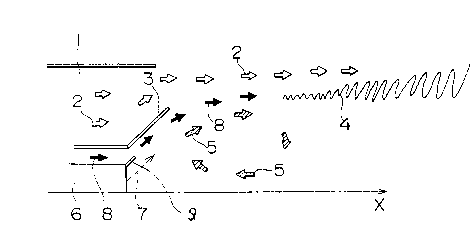Some of the information on this Web page has been provided by external sources. The Government of Canada is not responsible for the accuracy, reliability or currency of the information supplied by external sources. Users wishing to rely upon this information should consult directly with the source of the information. Content provided by external sources is not subject to official languages, privacy and accessibility requirements.
Any discrepancies in the text and image of the Claims and Abstract are due to differing posting times. Text of the Claims and Abstract are posted:
| (12) Patent: | (11) CA 2134893 |
|---|---|
| (54) English Title: | METHOD AND COMBUSTOR FOR THE COMBUSTION OF A PREMIXED GAS |
| (54) French Title: | METHODE ET CHAMBRE DE COMBUSTION POUR LA COMBUSTION D'UN PREMELANGE DE GAZ |
| Status: | Expired and beyond the Period of Reversal |
| (51) International Patent Classification (IPC): |
|
|---|---|
| (72) Inventors : |
|
| (73) Owners : |
|
| (71) Applicants : |
|
| (74) Agent: | GOWLING WLG (CANADA) LLP |
| (74) Associate agent: | |
| (45) Issued: | 1999-09-07 |
| (86) PCT Filing Date: | 1994-03-08 |
| (87) Open to Public Inspection: | 1994-09-15 |
| Examination requested: | 1994-11-01 |
| Availability of licence: | N/A |
| Dedicated to the Public: | N/A |
| (25) Language of filing: | English |
| Patent Cooperation Treaty (PCT): | Yes |
|---|---|
| (86) PCT Filing Number: | PCT/JP1994/000363 |
| (87) International Publication Number: | WO 1994020793 |
| (85) National Entry: | 1994-11-01 |
| (30) Application Priority Data: | ||||||
|---|---|---|---|---|---|---|
|
An object of the present invention is to overcome the
disadvantages of a conventional combustor having a fuel-air
premixing nozzle wherein variation in combustion rate
resulting from variation in the fuel concentration of the
premixed gas cause variation in flame length and may
eventually lead to the development of combustive vibration.
This invention provides a combustion method and combustor
which is characterized in that a fluid (8) containing no
fuel is fed between a premixed gas layer (2) formed by
injecting a premixed gas through a premixing nozzle (1) and
a hot gas layer (5) formed from a portion of the hot gas
resulting from the combustion of the premixed gas, the hot
gas layer (5) circulating or staying in a region downstream
of the outlet of the premixing nozzle (1).
Note: Claims are shown in the official language in which they were submitted.
Note: Descriptions are shown in the official language in which they were submitted.

2024-08-01:As part of the Next Generation Patents (NGP) transition, the Canadian Patents Database (CPD) now contains a more detailed Event History, which replicates the Event Log of our new back-office solution.
Please note that "Inactive:" events refers to events no longer in use in our new back-office solution.
For a clearer understanding of the status of the application/patent presented on this page, the site Disclaimer , as well as the definitions for Patent , Event History , Maintenance Fee and Payment History should be consulted.
| Description | Date |
|---|---|
| Inactive: IPC from MCD | 2006-03-11 |
| Inactive: IPC from MCD | 2006-03-11 |
| Inactive: IPC from MCD | 2006-03-11 |
| Time Limit for Reversal Expired | 2004-03-08 |
| Letter Sent | 2003-03-10 |
| Grant by Issuance | 1999-09-07 |
| Inactive: Cover page published | 1999-09-06 |
| Inactive: Final fee received | 1999-06-02 |
| Pre-grant | 1999-06-02 |
| Notice of Allowance is Issued | 1999-03-22 |
| Letter Sent | 1999-03-22 |
| Notice of Allowance is Issued | 1999-03-22 |
| Inactive: Status info is complete as of Log entry date | 1999-03-16 |
| Inactive: Application prosecuted on TS as of Log entry date | 1999-03-16 |
| Inactive: Approved for allowance (AFA) | 1999-02-19 |
| All Requirements for Examination Determined Compliant | 1994-11-01 |
| Request for Examination Requirements Determined Compliant | 1994-11-01 |
| Application Published (Open to Public Inspection) | 1994-09-15 |
There is no abandonment history.
The last payment was received on 1999-02-03
Note : If the full payment has not been received on or before the date indicated, a further fee may be required which may be one of the following
Please refer to the CIPO Patent Fees web page to see all current fee amounts.
| Fee Type | Anniversary Year | Due Date | Paid Date |
|---|---|---|---|
| MF (application, 4th anniv.) - standard | 04 | 1998-03-09 | 1998-01-27 |
| MF (application, 5th anniv.) - standard | 05 | 1999-03-08 | 1999-02-03 |
| Final fee - standard | 1999-06-02 | ||
| MF (patent, 6th anniv.) - standard | 2000-03-08 | 2000-02-07 | |
| MF (patent, 7th anniv.) - standard | 2001-03-08 | 2001-02-19 | |
| MF (patent, 8th anniv.) - standard | 2002-03-08 | 2002-02-18 |
Note: Records showing the ownership history in alphabetical order.
| Current Owners on Record |
|---|
| MITSUBISHI JUKOGYO KABUSHIKI KAISHA |
| Past Owners on Record |
|---|
| KATSUNORI TANAKA |
| NOBUO SATO |
| SATOSHI TANIMURA |
| SHIGEMI MANDAI |